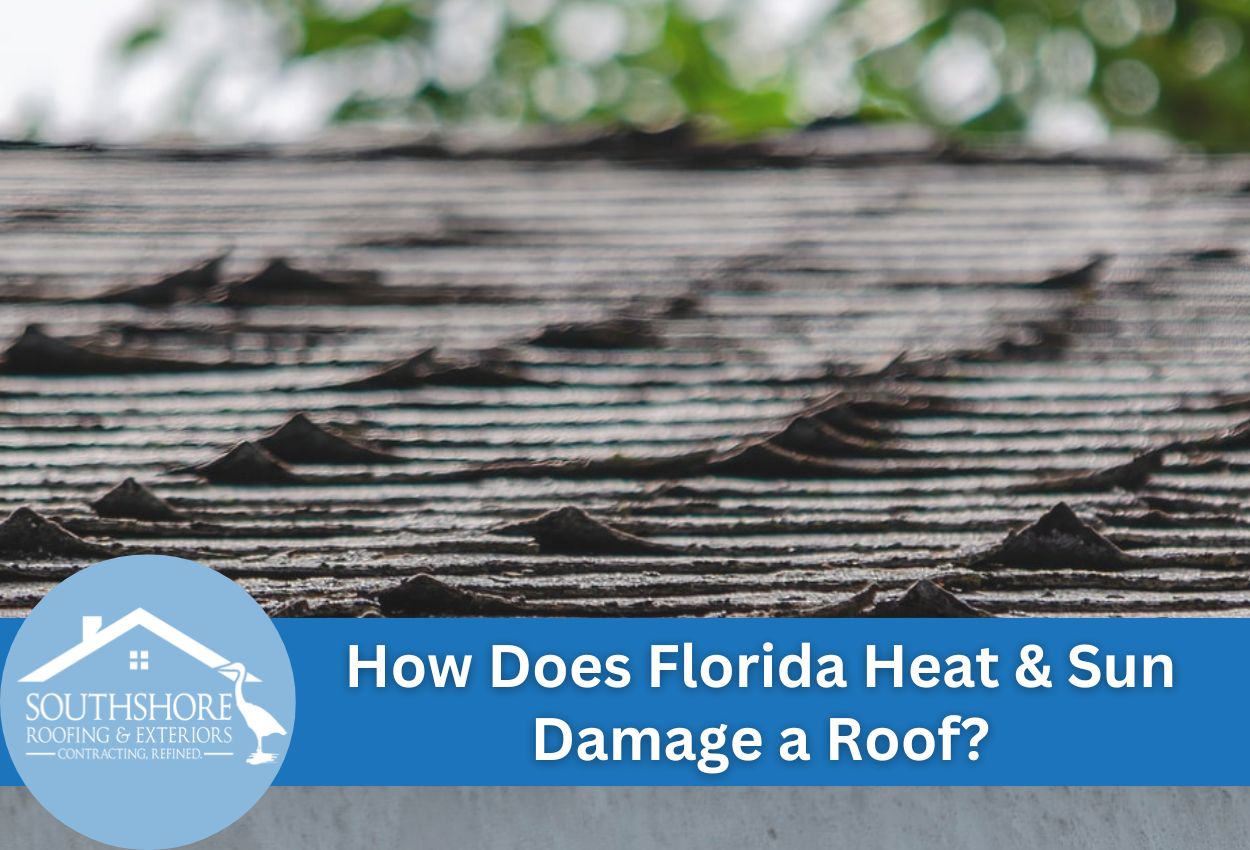Florida’s relentless sunshine and high temperatures create unique challenges for homeowners concerned about their roofing systems. With temperatures in Tampa regularly soaring above 90°F and humidity levels that amplify the effect of heat, roofing materials face accelerated deterioration that can significantly reduce their expected lifespan. The combination of intense UV rays, extreme heat, and moisture creates the perfect environment for roof damage that many property owners don’t fully understand until problems already form.
Recognizing the early signs of sun damage and understanding how high temperatures cause roof deterioration allows homeowners to implement protective strategies before major problems develop. From regular inspections to specially formulated heat-resistant materials, there are practical approaches to reduce the damaging effects of Florida’s intense solar exposure on residential and commercial roofing systems.
The Science Behind Heat-Induced Roof Damage
Understanding how Florida’s intense heat damages roofs requires looking at the physical and chemical processes at work. When Tampa’s temperatures soar day after day, roofing materials don’t merely get hot, they undergo complex changes that compromise their integrity and longevity.
Thermal cycling creates significant stress on roofing systems. As temperatures rise during the day, roofing materials expand, and when temperatures drop at night, these materials contract. This daily expansion and contraction cycle weakens the structural integrity of shingles, tiles, and metal panels over time. In Florida’s climate, where daytime temperatures can exceed 95°F before cooling considerably overnight, this cycle is particularly intense. The repeated stress loosens fasteners, creates gaps between materials, and eventually leads to cracks and leaks.
At the same time, UV radiation breaks down the chemical bonds in roofing materials. Asphalt shingles contain oils that give them flexibility and waterproofing properties, but constant UV exposure can cause these oils to evaporate, causing shingles to become brittle and prone to cracking. Even materials marketed as UV-resistant will eventually show signs of sun damage after extended exposure to Tampa’s powerful sunshine.
Warning Signs Your Roof is Suffering from Heat Damage
Identifying heat damage early can save Tampa homeowners hundreds in emergency roof repairs. The relentless Florida sun leaves behind visible evidence when it begins impacting your roofing system. By recognizing these warning signs promptly, you can address issues before they turn into major structural problems.
The most common visual indicators include curling or cupping shingles, which occur as heat causes uneven expansion and contraction of roofing materials. You may find blistering that appears as small bubbles on shingle surfaces where trapped moisture has evaporated during intense heat exposure. Granule loss also becomes evident as dark spots develop where protective granules have fallen off, often accumulating in gutters after heavy rains. Color fading represents another clear sign of UV degradation, particularly noticeable when comparing sun-exposed sections to shaded areas.
Inside your home, several indicators suggest that heat is compromising your roof. Unexplained increases in cooling costs often signal that excessive attic heat is starting to penetrate living spaces. An unusually hot attic, especially one that remains warm well into the evening hours, indicates poor ventilation and heat buildup beneath roofing materials. Water stains appearing on ceilings during heavy rains may result from heat-damaged underlayment that has lost its waterproofing properties. These interior signs warrant immediate inspection by a qualified Tampa roofing contractor who understands the unique challenges posed by Florida’s extreme climate conditions.
Long-Term Consequences of Unaddressed Heat Damage
If the heat damage is left unrepaired, what begins as minor deterioration can turn into catastrophic problems. In Tampa’s climate, where temperatures regularly exceed 90°F for months at a time, this progression happens faster than in more temperate regions. Heat-damaged shingles that initially show minor curling or granule loss will continue breaking down until they no longer provide enough protection for your home.
As deterioration advances, the underlayment beneath becomes exposed to direct sunlight, rapidly accelerating their breakdown. This compromises the water-resistant barrier protecting your roof deck, allowing moisture to penetrate and cause wood rot, mold growth, and eventual structural weakening. What might have been a simple shingle replacement can transform into a complete roof deck repair. Most Florida roofs with shingles are designed to last 25 to 30 years, but unaddressed heat damage can reduce this lifespan by 30% to 50%, forcing premature total replacement.
Innovative Roofing Technology That Combats Florida Heat
As Florida’s climate continues to challenge traditional roofing materials, the industry has responded with remarkable innovations specifically designed to withstand intense heat. Tampa homeowners now have access to advanced solutions that significantly outperform conventional roofing in our punishing summer conditions. These forms of technology not only extend the roof’s lifespan, they also substantially reduce cooling costs throughout the year.
Cool roofing systems represent one of the most effective heat-fighting forms of technology available today. These systems utilize specially formulated reflective coatings that can reflect up to 80% of solar radiation away from your home. Heat-reflective shingles are even available that incorporate special granules to bounce sunlight away rather than absorb it, keeping surface temperatures 50 to 60 degrees cooler than standard shingles during peak sunshine hours.
Advanced synthetic underlayments are also available to provide an additional thermal barrier that traditional felt underlayment cannot match, creating multiple layers of heat protection.
However, these materials work best when paired with proper attic ventilation and insulation. Ridge vents, solar-powered attic fans, and strategic soffit vents create continuous air circulation that prevents heat buildup beneath your roofing materials. When combined with adequate insulation that includes radiant barriers, these ventilation systems create a comprehensive defense against Tampa’s heat. The result is a roofing system that not only resists deterioration from high temperatures but also actively contributes to your home’s energy efficiency by minimizing heat transfer through the roofing structure.
When to Call Tampa Roofing Professionals
While a basic inspection can provide you with valuable insights, nothing replaces the trained eye of a professional roofer when evaluating heat-related damage. Tampa roofing experts bring specialized knowledge about how Florida’s unique climate affects different roofing materials over time. Professional inspectors are able to identify subtle warning signs that most homeowners miss, including minor membrane separations, early-stage adhesive failures, and small cracks that occur well before visible damage appears.
Scheduling professional roof inspections as many times a year as possible, ideally in spring and fall, to create opportunities to catch heat damage before it escalates into expensive problems. During these inspections, qualified contractors examine not just the surface of the roof, but also the underlayment’s condition, flashing, and attic ventilation efficiency. They may even use infrared technology to detect hidden moisture accumulation and heat pattern abnormalities that indicate compromised areas not visible to the naked eye.
When consulting with your Tampa roofing contractor, ask specific questions about heat-resistant options tailored to your neighborhood’s weather pattern. Ask about the Solar Reflectance Index (SRI) ratings on recommended materials and how they perform in Florida. You should also discuss warranty considerations carefully, focusing on coverage for heat-related deterioration and whether the warranty accounts for Tampa’s climate challenges.
Quality contractors will explain the difference between standard manufacturer warranties and enhanced coverage options that protect against premature aging from UV exposure and high-temperature roof deterioration.
Preventative Maintenance: Extending Your Roof’s Life Despite the Heat
Implementing a consistent maintenance routine is crucial for Tampa homeowners wanting to maximize their roof’s lifespan in Florida’s punishing heat. By taking the right steps throughout the year, you can significantly reduce heat-related damage and postpone the chance of needing a replacement. The key is understanding that preventative care isn’t an option; it’s essential for protecting your investment.
Some of these preventative tasks include:
- Inspecting for and replacing any cracked, curled, or missing shingles that developed during the summer’s peak temperatures.
- Trimming overhanging branches that prevent proper airflow across your roof’s surface, as good air circulation helps dissipate heat buildup.
- Applying specialized roof coatings designed for UV protection every 3 to 5 years to refresh your roof’s heat-reflective properties and seal minor cracks before they expand during thermal cycling.
Long-term planning is equally important for Florida homeowners. Consider making gradual upgrades over time to more heat-resistant materials during partial repairs rather than waiting for complete failure. When budgeting for eventual replacement, factor in the value of premium materials with higher temperature tolerance and reflective properties. While they may cost more initially, they offer significant savings through an extended lifespan and reduced cooling costs.
Documenting your maintenance history also comes in handy when filing insurance claims for weather-related damage, as it demonstrates your commitment to proper roof care despite the challenging conditions created by Florida’s relentless heat.
Protect Your Home with Heat-Resistant Roofing Solutions From SouthShore Roofing & Exteriors
Don’t wait until Florida’s relentless heat causes irreversible damage to your roof. The warning signs we’ve discussed, such as curling shingles, increased energy bills, and deteriorating materials, require immediate professional attention before they lead to expensive structural issues.
SouthShore Roofing & Exteriors specializes in heat-resistant roofing solutions that are designed to handle Tampa’s unique weather patterns. Our expert team can assess the current condition of your roof, recommend appropriate heat-fighting technology, and implement preventative maintenance strategies that extend your roof’s lifespan despite extreme temperatures.
Call SouthShore Roofing & Exteriors at (813) 400-3329 to schedule your comprehensive roof inspection and discuss heat-resistant options tailored to your home’s specific needs. Our local experts understand Florida’s climate and are ready to help protect your home year-round.




